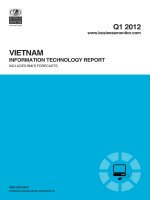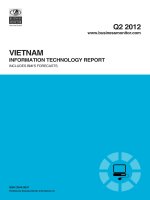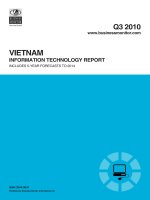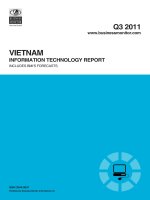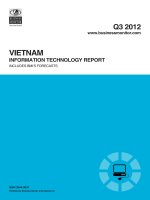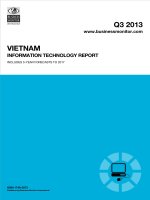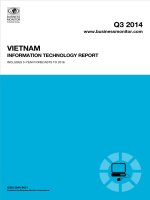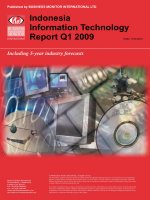Indonesia information technology report q3 2012
Bạn đang xem bản rút gọn của tài liệu. Xem và tải ngay bản đầy đủ của tài liệu tại đây (586.32 KB, 75 trang )
Q3 2012
Published by Business Monitor International Ltd.
www.businessmonitor.com
INFORMATION TECHNOLOGY REPORT
ISSN 1750-5070
Published by Business Monitor International Ltd.
INDONESIA
INCLUDES BMI'S FORECASTS
Business Monitor International
85 Queen Victoria Street
London
EC4V 4AB
UK
Tel: +44 (0) 20 7248 0468
Fax: +44 (0) 20 7248 0467
Email:
Web:
© 2012 Business Monitor International.
All rights reserved.
All information contained in this publication is
copyrighted in the name of Business Monitor
International, and as such no part of this publication
may be reproduced, repackaged, redistributed, resold in
whole or in any part, or used in any form or by any
means graphic, electronic or mechanical, including
photocopying, recording, taping, or by information
storage or retrieval, or by any other means, without the
express written consent of the publisher.
DISCLAIMER
All information contained in this publication has been researched and compiled from sources believed to be accurate and reliable at the time of
publishing. However, in view of the natural scope for human and/or mechanical error, either at source or during production, Business Monitor
International accepts no liability whatsoever for any loss or damage resulting from errors, inaccuracies or omissions affecting any part of the
publication. All information is provided without warranty, and Business Monitor International makes no representation of warranty of any kind as
to the accuracy or completeness of any information hereto contained.
INDONESIA INFORMATION
TECHNOLOGY REPORT
Q3 2012
INCLUDES 5-YEAR FORECASTS TO 2016
Part of BMI’s Industry Report & Forecasts Series
Published by: Business Monitor International
Copy deadline: June 2012
Indonesia Information Technology Report Q3 2012
© Business Monitor International Ltd Page 2
Indonesia Information Technology Report Q3 2012
© Business Monitor International Ltd Page 3
CONTENTS
Executive Summary 5
SWOT Analysis 7
Indonesia IT Sector SWOT 7
Indonesia Telecoms Industry SWOT 8
Indonesia Political SWOT 9
Indonesia Economic SWOT 10
Indonesia Business Environment SWOT 11
Asia Pacific IT Risk/Reward Ratings 12
Table: Asia Pacific IT Risk/Reward Ratings 17
IT Markets Overview 18
IT Penetration 18
IT Growth and Drivers 20
Sectors And Verticals 22
Market Overview 26
Table: Key Ministers And Departments 26
Table: Bandung High-Tech Valley SWOT 27
Hardware 27
Software 30
Services 31
Special Focus: Banks 33
Industry Developments 34
Industry Forecast 37
Market Drivers 37
Table: Indonesia IT Sector – Historical Data & Forecasts (US$mn Unless Otherwise Stated) 39
Industry Forecast Internet 40
Table: Telecoms Sector – Internet – Historical Data And Forecasts 40
Competitive Landscape 42
Hardware 42
Software 44
IT Services 45
Internet Competitive Landscape 47
Macroeconomic Forecast 48
Table: Indonesia – Economic Activity 50
Company Profiles 51
IBM 51
Hewlett-Packard 56
Oracle Corp 62
Sigma (telkomsigma) 66
Indonesia Information Technology Report Q3 2012
© Business Monitor International Ltd Page 4
Indonesia Demographic Outlook 68
Table: Indonesia's Population By Age Group, 1990-2020 ('000) 69
Table: Indonesia's Population By Age Group, 1990-2020 (% of total) 70
Table: Indonesia's Key Population Ratios, 1990-2020 71
Table: Indonesia's Rural And Urban Population, 1990-2020 71
BMI Methodology 72
How We Generate Our Industry Forecasts 72
Transport Industry 72
Sources 73
Indonesia Information Technology Report Q3 2012
© Business Monitor International Ltd Page 5
Executive Summary
BMI View: Indonesian IT spending is expected to reach US$6.0bn in 2012, up 12%, slightly higher than
previously forecast, despite a weakening economic backdrop. BMI still expects the Indonesian market to
be one of the region's fastest-growing IT markets over our five-year forecast period. In 2012, resilient
private consumption and capital investment should support demand for IT products and services and PC
penetration remains at around 6%, giving this huge market unrivalled long-term growth potential. Rising
computer penetration and growing affordability should ensure that the market remains firmly in positive
growth territory.
Headline Expenditure Projections
Computer hardware sales: US$3.8bn in 2011 to US$4.3bn in 2012, +11.0% in US dollar terms.
Forecast in US dollar terms upwardly revised due to analyst Adjustment, with growing affordability
and credit availability driving sales in the consumer segment.
Software sales: US$599mn in 2011 to US$695mn in 2012, +16% in US dollar terms. Forecast in US
dollar terms unchanged and progress will depend on the success in bringing down illegal software use.
IT services sales: US$880mn in 2011 to US$1.0bn in 2012, +14.0% in US dollar terms. Forecast in US
dollar terms unchanged, with a key growth area being cloud services, which could be worth around
US$100mn by 2016.
Risk/Reward Ratings: Indonesia's score was 42.8 out of 100.0. Indonesia ranked fifth from bottom of
the Asia region in our latest RRR table, behind the Philippines and ahead of Vietnam, Sri Lanka, India
and the Thailand.
Key Trends & Developments.
With ICT penetration of only 20% and development restricted to richer areas such as Java, the
market has much growth potential. However, Indonesia's uneven development and digital divide
are major barriers to faster growth within this potentially huge IT market.
Spending in some key IT verticals, such as financial services and banking should continue to be
significant in 2012 as Bank Indonesia turns dovish. Government infrastructure investments
should also provide a boost to the business sector. Government IT spending is expected to
increase and could have accounted for as much as 25% of the IT market in 2011, with reports
that the government was encouraging state companies to use more IT services.
Indonesia Information Technology Report Q3 2012
© Business Monitor International Ltd Page 6
An active approach by the government to encourage IT development, led by the National ICT Council,
should stimulate spending through a series of infrastructure and education initiatives. Around 30-35mn
Indonesian companies are estimated to lack any IT-based solutions and enterprise resource planning
(ERP) and other e-business applications will find increasing popularity in the small and medium-sized
enterprise (SME) market.
Indonesia Information Technology Report Q3 2012
© Business Monitor International Ltd Page 7
SWOT Analysis
Indonesia IT Sector SWOT
Strengths
Large potential market.
The market may be entering a faster growth stage. It is forecast to grow quicker
than most other Association of South East Asian Nations (ASEAN) markets over
the forecast period due to its underdeveloped nature.
Weaknesses
Computer penetration is among the lowest in South East Asia, estimated at only
1.5%.
Underdeveloped telecommunications infrastructure due to years of government
control and slow progress in deregulation.
Lack of government support, and there is still no unified ICT ministry.
History of recent political instability.
Legal concerns, such as intellectual property rights, are a deterrent to foreign
direct investment.
Opportunities
Some positive trends: computer ownership and internet access are on the rise,
and the government is showing signs of taking intellectual property more
seriously.
Per capita IT spending to increase by 50% over 2010-2014.
Opportunities exist in services such as system integration, support systems,
training, professional services, outsourcing and internet services.
Computer sales are predicted to grow faster than almost anywhere else in the
ASEAN over the next few years, although from a lower base.
Threats
Continuing lack of government action to support increased PC penetration and
internet access, or drive ICT sector development.
The global economic slowdown may hit key demand segments.
Indonesia Information Technology Report Q3 2012
© Business Monitor International Ltd Page 8
Indonesia Telecoms Industry SWOT
Strengths
A rapidly growing mobile sector due to the emergence of greater competition.
The presence of key strategic investors, including SingTel, ST Telemedia of
Singapore, Telekom Malaysia, Maxis of Malaysia, Hong Kong's Hutchison and
the UAE's Etisalat.
Weaknesses
Security and corruption issues still make Indonesia a risky investment climate.
Limited mobile spectrum due to overcrowding in the sector following the
government decision to open the market to greater competition.
Mobile broadband spectrum fees remain high for operators, reducing the
implementation and variety of tariffs.
Operators struggling with raised costs after the government forced companies
to charge a fee based on cost rather than share part of their revenues.
Opportunities
The mobile market expected to surge over the coming years, reaching nearly
431mn people over the forecast period.
The popularity of mobile value-added/data services offers potential to
international content providers.
The growth of 3G will lead to investment opportunities for content providers and
distributors.
Threats
A government registration scheme could lead to short-term fall in fixed wireless
and mobile users as non-registrants are deactivated.
The dominance of the prepaid market leading to falling average revenue per
user rates.
Mobile operators could put too much emphasis on 3G mobile network
expansion when consumer demand is unproven at the expense of 2G growth.
Indonesia Information Technology Report Q3 2012
© Business Monitor International Ltd Page 9
Indonesia Political SWOT
Strengths
Indonesia managed a successful transition to democracy in 2004. In addition,
the 2009 parliamentary and presidential elections passed peacefully, signalling
the consolidation of the democratic process. Since 2009, the government has
shown further signs of improvement in both efficacy and engagement.
The military's role in politics has gradually been reduced. The prospects of a
military coup – which seemed a real possibility in the late 1990s and early
2000s – have diminished substantially. As the military's role in politics continues
to wane, Indonesia's political stability should likewise improve.
Weaknesses
Indonesia's domestic political scene is characterised by a proliferation of
minority parties, and formal and informal coalitions are necessary to govern and
legislate. Moreover, the efficiency of state institutions is encumbered by
bureaucracy and corruption. Prospects for reform are beset with numerous
challenges, such as the long-running practice of politicians promising
government positions to campaign supporters.
The archipelago was impacted by separatist rebellion and ethnic violence in the
late 1990s and early 2000s, which took great efforts to bring to heel. In the
event of a new economic crisis, calls for regional secession could re-emerge.
Opportunities
President Susilo Bambang Yudhoyono's Democratic Party had a strong
showing in the 2009 parliamentary elections. Coupled with a strong mandate
following his re-election in the same year, the implementation of policies in the
legislature should become less problematic.
Indonesia's status as the world's most populous Muslim country leaves it well
positioned to speak out on global Islamic issues and act as a bridge between
the Middle East and the Asia Pacific region.
Threats
Regional militant group Jemaah Islamiah (JI) poses a lingering threat to security
in Indonesia. JI is blamed for a series of attacks, including the Bali bombings of
October 2002 and the Jakarta bombings of July 2009.
The fact that Indonesia subsidises basic goods means that when the
government raises prices, there is a risk of public unrest, or at least a political
backlash. Additionally, Indonesia's population is extremely young, with more
than 50% of Indonesians younger than 30. Younger populations have
historically been a predictor of political instability.
Indonesia Information Technology Report Q3 2012
© Business Monitor International Ltd Page 10
Indonesia Economic SWOT
Strengths
Indonesia's strategic location between the Indian and Pacific Oceans and its
adjacency to major east-west trade routes make it an important economy in the
region. Indonesia is also resource-rich and is the world's largest producer of
palm oil.
Indonesia has a low cost and large supply of available labour resources. Its
labour force, the fourth largest in the world, is also one of the world's youngest.
Weaknesses
Indonesia's economy is not growing fast enough to reduce unemployment, with
the rate still relatively high at 6.8% as of February 2011. Many are forced to
work in the informal sector. Of particular concern is the youth unemployment
rate, which is five times the overall rate.
Indonesia's physical infrastructure is considered sub-standard. The archipelagic
nature of the country makes it difficult to weave national infrastructure together.
Despite an ambitious infrastructure revitalisation plan, the country currently
compares unfavourably with its Association of Southeast Asian Nations peers.
Opportunities
Indonesia could attract much-needed foreign investment by strengthening its
business environment, particularly through reform of its unreliable legal system.
Indonesia stands to benefit from the rise of Islamic financing, having adopted
new legislation in early 2008 designed to tap into this rapidly expanding sphere.
With an overall market share of only 3%, growth prospects for Islamic banking
in the world's largest Muslim country are enormous.
Threats
Production at Indonesia's ageing oil fields has been in decline since the mid-
1990s. The country has therefore become a net importer of crude oil in recent
years, putting downward pressure on its current account position. Furthermore,
rising oil prices have begun to pressure Indonesia's current account, where it
typically runs a healthy surplus. The resumption of the Cepu field in late 2009
may help to alleviate Indonesia's dependence on foreign oil.
Indonesia is perceived as one of Asia's riskier destinations. This leaves the
economy vulnerable to sudden capital outflows at times of risk aversion, which
can lead to sharp swings in the currency.
Indonesia Information Technology Report Q3 2012
© Business Monitor International Ltd Page 11
Indonesia Business Environment SWOT
Strengths
Indonesia is South East Asia's largest economy with a nominal GDP of
US$500bn and is the world's fourth most populous country with more than
240mn people. It thus offers investors a vast home market in which to do
business.
As a member of the Association of South East Asian Nations' Free Trade Area,
Indonesia is committed to lowering tariff and non-tariff barriers to trade.
Weaknesses
Corruption remains a major problem. Indonesia ranked 100th out of 182
countries surveyed in Transparency International's 2011 Corruption Perceptions
Index, where a low ranking denotes a higher degree of corruption.
Indonesia's excessive bureaucracy makes it a difficult place to do business.
Among Asian economies, Indonesia has the longest period to start a business.
Labour laws are also considered excessive.
Opportunities
President Susilo Bambang Yudhoyono's administration has gradually been
reforming the business environment, particularly by strengthening the legal
system and fighting corruption. If sustained, this would boost investor interest in
Indonesia. Although reform has been slow, the government has shown itself to
be increasingly willing to address important issues.
Indonesia has been amending its debt and banking regulations, with the aim of
attracting Islamic financial activities. Over the past five years, Islamic banking
growth has averaged more than 65%.
Threats
Recent high-level business disputes between the government and foreign
investors demonstrate that even after investments are up-and-running, there is
still scope for legal problems or obstacles posed by legal wrangling.
Security threats are a concern for investors. Despite several of its top leaders
having been arrested in recent years, militant group Jemaah Islamiah remains
active. There is also a low-level threat from separatist rebels or from inter-
communal tensions.
Indonesia Information Technology Report Q3 2012
© Business Monitor International Ltd Page 12
Asia Pacific IT Risk/Reward Ratings
BMI's Asia Pacific IT Risk/Reward Ratings (RRR) compares the potential of a selection of the region's
markets over our forecast period through to 2016. Our Q312 ratings reflect our consideration of the
political and economic risks, as well as the risks associated specifically with IT intellectual property (IP)
rights protection and the implementation of state spending projects.
While there were changes to the countries' individual scores, the rankings were largely unaffected. The
only change came in the form of Indonesia overtaking India and Thailand to become the eighth-ranked
country among the 12 covered in the Asia Pacific region by BMI.
Singapore retained its leader position with an IT Ratings score of 74.1. Although Singapore's IT market is
significantly smaller than many of its regional peers, the country has other redeeming factors. For
example, Singapore is highly urbanised with a pool of skilled labour. The country is also strategically
placed at the heart of South East Asia amid emerging markets such as Indonesia and Thailand. Its strong
infrastructure, which includes access to major submarine cable networks and high-speed broadband
connectivity, political stability and pro-business environment attract foreign investors and spur
technological developments.
Singapore's ambitions to emerge as a regional cloud computing hub will fuel vendor investment in service
capabilities. In February 2011, the Infocomm Development Authority of Singapore and the Information
Technology Standards Committee (ITSC) formed a Cloud Computing Standards Coordinating Task Force
to 'address the industry demands for cloud computing standards and co-ordinate the cloud computing
standardisation efforts across the different Technical Committees in ITSC'.
Australia closed the gap with Singapore by achieving an IT Ratings score of 73.2, up from 70.9 in the
previous quarter. The upgrade was largely due to an improvement in its IT Market score, although an
increase in its Country Risk score aided as well. Due to the country's sheer size, it is inevitable that
certain regions suffer from a deficiency in IT network and services. However, the government has been
looking to resolve the issue with its ambitious National Broadband Network (NBN), which aims to
deliver nationwide high-speed broadband connectivity with a combination of fibre, fixed-wireless and
satellite technologies. The introduction of high-speed broadband connectivity should fuel demand for
sophisticated services such as cloud computing, which is already being embraced by the public sector and
enterprises, machine-to-machine (M2M) connectivity and telepresence as well as devices as the industry
moves towards ubiquitous connectivity and internet-connected homes.
Hong Kong saw its IT Ratings score rise to 72.6 from 69.4 in the previous quarter. Like Australia, the
improvement was fuelled by an upgrade in its IT Market score, although the positive effect was partially
Indonesia Information Technology Report Q3 2012
© Business Monitor International Ltd Page 13
offset by a decline in the territory's Country Risk score. Hong Kong has one of the lowest fibre broadband
tariff rates in the world, and this provides the backbone for next generation IT services such as cloud
computing and data centres. Hong Kong is also well connected to the international submarine cable
network, and the territory is one of the 11 landing sites for the new 10,400km Asia Pacific Gateway
(APG) system. The network, which is scheduled to become operational by June 2014, is designed for an
initial transmission speed of 40Gbps per wavelength, using Digital Coherent detection and Optical Add-
Drop Multiplexing technologies, according to Japan's NEC. The APG system will be able to
accommodate 100Gbps for increasing efficiency and capacity in the future.
Similar to its developed peers in the region, South Korea is also encouraging the utilisation of cloud
computing by small businesses. New cloud computing offerings and increased competition in this
segment are expected to fuel growing demand to use this technology. Other areas of growth include M2M
and telecare, which are led by technological advancements in the underlying networks. At the end of
January 2012, there were 44mn 3G subscribers and 2.8mn 4G (comprising WiBro and LTE) users. By
comparison, there were only 6.7mn 2G subscribers.
However, besides being vulnerable to the global headwind, South Korea's economy has its own
problems. Firstly, South Korea's household debt situation remains an overriding concern. While a
collapse in the housing debt market looks to be an unlikely scenario, considerable risk remains from
households' debt servicing capacities as the economy heads south. Secondly, its external debt situation
puts the economy in a very precarious position. Given that a significant portion of external debt is held by
foreign bank branches and is short-term in nature, a sudden bout of risk aversion could see substantial
foreign capital outflows.
Malaysia remained in fifth position in our Q312 regional ratings. There are increasingly attractive
opportunities in the IT services area as the government implements measures to make Malaysia a growing
regional services and outsourcing hub. Guiding the government and industry is the country's Economic
Transformation Programme, which has earmarked areas such as cloud computing as one of its top 10
strategic technology priorities. The rollout of the High Speed Broadband network will also boost IT
spending outside the Klang Valley and help the country achieve a household broadband penetration rate
of 75% by 2015. Other projected growth and PC market drivers include a rise in the PC penetration level
from about 35%, tax exemptions for notebooks and growth in disposable incomes.
Our Chinese hard landing view is playing out well with evidence such as the People's Bank of China's
decision to cut its reserve requirement ratio in February 2012 and a sharp drop in the HSBC flash
purchasing managers' index for China to 48.1 in March 2012 from 49.6 in the previous month providing
support.
Indonesia Information Technology Report Q3 2012
© Business Monitor International Ltd Page 14
A Chinese economic slowdown would negatively affect the IT market growth, albeit at a lesser extent
than other industries such as infrastructure or automotives. Factors such as the vast potential rural market
and a commitment to modernisation in sectors such as education, healthcare and manufacturing are
among the expected drivers. We expect growing interest in cloud computing will be stimulated by the
establishment of government pilot programmes. Besides market risks such as poor intellectual property
rights protection, piracy and a lack of business transparency, the overall pace of development has been
comparatively slow. However, companies have started to seek the help of foreign counterparts to
accelerate the process. For example, China Mobile collaborated with South Korea's SK Telecom to
develop technologies such as M2M while China Telecom formed a strategic partnership with Internet
Initiative Japan to provide cloud computing services in China.
In the Philippines, the IT market will be driven by the local IT and business process outsourcing (BPO)
sector. The BPO industry, which accounts for around 30% of IT spending, continues to grow, and it is in
the midst of expanding operations outside Metro Manila. In order to facilitate the expansion, network
operators are extending fibre optic network throughout the country to provide high capacity
connectivity. The Philippines is also looking at cloud computing as the next growth driver, with the
private sector leading the charge. Domestic firms have partnered with foreign IT companies in order to
provide the necessary infrastructure and technology to expand their products portfolio, which should
attract businesses including small and medium-sized enterprises (SMEs) as they look to cut costs amid an
uncertain global economy.
Indonesia is ranked eighth with an IT Ratings score of 42.8, up from 39.1 in the previous quarter. The
significant improvement was driven by an upgrade in its IT Market, Country Structure and Country Risk
scores. With ICT penetration of only about 20% and development restricted to richer areas such as Java,
the Indonesian IT market has much growth potential. BMI expects the Indonesian market to be one of the
fastest growing in the region over the five-year forecast period, and this has been reflected in the country's
movement up the Risk/Reward Ratings table. Spending in some key IT verticals such as financial services
and banking should continue to be significant in 2012. Government IT spending is also expected to
increase and could have accounted for as much as 25% of the IT market. The SME sector will drive
demand for basic hardware and applications as enterprises focus on enhanced productivity.
Indonesia is also susceptible to the global headwind, and weak demand from China will pressure
Indonesia's trade surplus. However, we expect resilient private consumption and capital investment to
enable the archipelago to continue to outperform the region. Wage growth in Indonesia has been strong as
the economy's growth has begun to translate into higher employment. Reports indicate that minimum
wages have been raised by as much as 20% in some cities, and double-digit wage growth is widely
expected. Consumer strength has translated into increasing demand for goods previously inaccessible to
the majority of Indonesians, such as automobiles and consumer electronics.
Indonesia Information Technology Report Q3 2012
© Business Monitor International Ltd Page 15
India's IT industry possesses significant growth potential as only a small portion of the country's massive
population has access to a personal computer. Significant opportunities will also be created by demand
from Indian businesses and government agencies to help use more advanced IT solutions to improve
efficiency and reduce costs. Consequently, India had a relatively high IT Market score of 52.5. However,
the country was significantly let down by its weak Country Structure score.
Although India has made strides to address its electricity deficit (the country's power supply deficit
improved from a 11.1% power deficit in Q1 FY2008/09 to a 6.6% deficit in power supply during the first
quarter of FY2011/12), that deficit remains sizeable and India needs to boost investment to cope with
demand, which has been growing at a significant pace, fuelled by rapid population growth and continued
high levels of economic growth. This is set to continue and presents a major obstacle to the country's
business environment and economic development.
However, it is insufficient for India to only address power generation as the annual power loss through
the country's power grid system is estimated at more than 30%. As of 2006, about three-quarters of India's
villages received an electricity supply, but only 43% of rural households had been provided with a
permanent supply. According to the Planning Commission of India, 600mn people are not connected to
the power grid. That said, India's transmission grids sector is showing significant growth potential for
private investors. The sector is undergoing a process of liberalisation, requiring state-run companies such
as state-owned Power Grid Corporation of India to compete with private sector companies for
electricity transmission projects.
The short-term outlook on Thailand's IT sector is largely mixed. Local media have reported that retail IT
sales are expected to decline by 15% year-on-year in Q112, attributable to higher living costs.
Furthermore, the effects of the flooding are still felt with higher end-product prices in light of supply
chain disruptions to hard disk drives. However, the industry envisages a recovery in H212 due to the
launch of new products such as ultrabooks, which are expected to become more affordable, government-
led projects and increasing 3G network coverage. BMI shares the sentiment as the government has been
trying to fulfil its election promise of bridging the digital divide in the country.
The Smart Thailand project, which was first unveiled in September 2011, aims to boost the country's
competitiveness through greater ICT development. The initiative rightly looks at integrating ICT
particularly into the government sector and expanding and upgrading the underlying network
infrastructure, which would improve the overall business environment.
Smart Thailand has a two-pronged approach. The Smart Network project, which will cost THB80bn, aims
to expand broadband coverage to 95% of the population by 2020, up from 80% in 2015 and the current
33%. The Smart Government project aims to transition all 800 government services across the education,
health, government service and agriculture sectors to an electronic platform, which should improve
Indonesia Information Technology Report Q3 2012
© Business Monitor International Ltd Page 16
service quality and the communication between agencies. If both measures are successfully implemented,
Thailand should become more attractive to companies and foreign investors.
Vietnam remains in 11th position with an IT Ratings score of 33.5. While the sizeable population,
growing affluence and increasing middle class present long-term potential for IT demand, like India,
Vietnam's poor Country Structure score has negatively affected the country's attractiveness. The
government has digital divide programmes to boost internet and digital utility in rural areas, which
theoretically should help to fuel market growth and open PC ownership to a growing number of rural
inhabitants. Moreover, Vietnam's gradual integration into global trade networks such as ASEAN and the
WTO has helped reduce tariff barriers and prices, and has increased opportunities. However, overall
progress has been slow, partially due to a lack of clear vision and state-owned companies' dominance in
the ICT market.
There were no changes to Sri Lanka's IT Rating score of 28.3, although we highlight that the country
holds long-term potential in light of the restoration of peace and improvements in the security situation,
which will help to release pent-up demand for IT solutions. The country has felt the effects of instability
over the years, from disruption of distribution channels and a flourishing grey market to the
underdeveloped telecoms infrastructure. However, Sri Lanka will feature on IT vendors' radars as one of
the best potential growth prospects in South Asia. Computerisation has only just started in government
services. Major public and private sector organisations remain largely underpenetrated in terms of basic
enterprise software.
However, initiatives such as network expansion projects by telecoms providers to increase internet
penetration rates in Sri Lanka and free training tools for SMEs from the International Finance Corporation
(a member of the World Bank Group) to boost adoption of IT services could help the country to close the
gap with its regional peers.
Indonesia Information Technology Report Q3 2012
© Business Monitor International Ltd Page 17
Table: Asia Pacific IT Risk/Reward Ratings
Limits Of Potential Returns
Risks To Realisation Of
Potential Returns
Country IT Market
Country
Structure Limits
Market
Risks
Country
Risk Risks
IT
Rating
Regional
Rank
Singapore 57.0 100.0 72.1 70.0 85.1 79.0 74.1 1
Australia 60.0 95.0 72.3 80.0 72.2 75.3 73.2 2
Hong Kong 53.3 100.0 69.7 70.0 85.7 79.4 72.6 3
South Korea 53.3 70.0 59.2 75.0 76.0 75.6 64.1 4
Malaysia 44.0 55.0 47.9 35.0 77.7 60.6 51.7 5
China 55.6 30.0 46.7 35.0 65.1 53.1 48.6 6
Philippines 39.3 45.0 41.3 42.5 53.6 49.1 43.7 7
Indonesia 41.3 40.0 40.8 35.0 55.8 47.5 42.8 8
India 52.5 15.0 39.4 45.0 53.6 50.1 42.6 9
Thailand 40.0 20.0 33.0 35.0 70.3 56.2 39.9 10
Vietnam 38.1 15.0 30.0 35.0 45.9 41.5 33.5 11
Sri Lanka 30.0 10.0 23.0 35.0 44.2 40.5 28.3 12
Regional Average 47.0 49.6 47.9 49.4 65.4 59.0 51.3
Scores out of 100, with 100 highest. The IT Risk/Reward Rating is the principal rating. It comprises two sub-ratings,
'Limits Of Potential Returns' and 'Risks To Realisation Of Returns', which have a 70% and 30% weighting
respectively. In turn, the 'Limits' rating comprises Market and Country Structure, which have a 70% and 30% weighting
respectively and are based upon growth/size/maturity/govt policy of IT industry (Market) and the broader
economic/socio-demographic environment (Country). The 'Risks' rating comprises Market Risks and Country Risk,
which have a 40% and 60% weighting respectively and are based on a subjective evaluation of industry regulatory
and IP regulations (Market) and the industry's broader Country Risk exposure (Country), which is based on BMI's
proprietary Country Risk ratings. The ratings structure is aligned across the 14 industries for which BMI provides
Risk/Reward methodology and is designed to enable clients to consider each rating individually or as a composite,
depending on their exposure to the industry in each particular state. For a list of the data/indicators used, please
consult the appendix at the back of the report. Source: BMI
Indonesia Information Technology Report Q3 2012
© Business Monitor International Ltd Page 18
IT Markets Overview
IT Penetration
Across Asia, government ICT initiatives
and growing affordability will help to
drive increases in PC penetration during
BMI's five-year forecast period. While
some cities and regions stand out, there is
an unbalanced pattern of regional
development, with PC penetration in
countries such as Singapore above 50%,
while in other countries, such as
Indonesia, it is below 5%.
The two Asian giants, China and India,
embody the region's growth potential, as
in both countries computer ownership
remains the preserve of a minority. In China, PC penetration is only around 30% in 2012 – although it is
far higher in cities such as Shanghai and Beijing and urban PC penetration is projected to pass 60% by
2016. In India, less than 5% of people own a computer. However, some 45% of the population is under
25, which provides a promising demographic context for increased PC ownership. PC penetration in
Vietnam is estimated by BMI at around 20% in 2012. Notebooks are owned by an estimated 10% of the
Vietnamese population, which points to significant growth potential for the local PC market.
Lower price will help to drive higher PC penetration in developing markets. The average price of a PC in
the Indian market has nearly halved over the past few years and rising incomes and greater credit
availability will continue to bring computers within the reach of lower-income demographics. Even in
more mature markets, there is room for development, however, with official data suggesting that as many
as 25% of Hong Kong households do not have a computer at home
Around the region, affordable computer programmes continue to find favour with governments. In
China, a subsidised household electronics products initiative aimed at rural residents has helped to boost
PC sales in areas where penetration was low. In Australia, national and state governments continue to roll
out new initiatives, with the Victoria government investing more than US$150mn in IT in schools.
In Indonesia, PC penetration of around 3% could double by 2016 if government initiatives are followed
through. The Indonesian government is also rolling out new e-learning initiatives, with a target of raising
Narrowband Penetration
Per 100 Population
e/f = BMI estimate/forecast. Source: BMI, Regulators
Indonesia Information Technology Report Q3 2012
© Business Monitor International Ltd Page 19
the current 1:3,200 ratio of PCs to students in public schools to 1:20. Meanwhile, the Vietnamese
government has launched a programme entitled One Teacher-One Computer, which offers discounts on
PCs for teachers and students.
A similarly broad range is found with respect to internet penetration. The highest levels of internet
penetration are found in South Korea, Hong Kong, Singapore, and Australia, with estimated 2012
penetration rates of 76.9%, 74.0% and 73.3% and 71.0% respectively. Singapore has by far the highest
rate of broadband penetration, which was estimated at 189.5% in 2012. Meanwhile, the Philippines has
the lowest levels of internet usage, with just 8.3% narrowband and 7.4% broadband penetration estimated
in 2012.
The fastest growth is expected in
Indonesia, where internet penetration is
projected to leap from 45.4% in 2012 to
68.9% in 2016, and the Philippines,
where penetration is forecast to reach
12.6% by 2016. India is still at only
11.8% internet penetration despite an
improvement in fixed-line infrastructure,
and penetration is forecast to reach only
16.2% by 2016. Steady growth is also
projected for Sri Lanka, where
penetration is projected to increase from
18.8% to 25.4% by 2016. Some 56.4% of
Malaysians have internet access in 2012.
Dial-up technology is still the dominant access method in many states. However, even in developing
markets, the number of broadband subscribers continues to gain ground steadily. Broadband penetration
has been boosted by a growing number of mobile broadband users, as 3G mobile services are expanded
across the region. In China, broadband penetration is on course to reach 20.9% by 2016. In India,
penetration should increase more than double to reach 2.8% by 2016 from around 1.2% currently,
although this remains below government targets. Sri Lanka will also see continued solid growth in
broadband penetration, which is projected to reach 21.7% by 2016.
Across the region, government programmes are an important driver of ICT penetration. The Chinese
government has a five-year plan to make the internet available in every administrative village in central
and eastern China and every township in the west. In Australia, the government's commitment to develop
the National Broadband Network should further the development of Australia's digital economy.
Broadband Penetration
Per 100 Population
e/f = BMI estimate/forecast. Source: BMI, Regulators
Indonesia Information Technology Report Q3 2012
© Business Monitor International Ltd Page 20
Meanwhile, the growth of Wi-Fi coverage will be one driver of notebook sales in places such as Hong
Kong, where the government has committed another HKD200mn to the deployment of a Wi-Fi network
covering more than 200 public venues.
IT Growth and Drivers
Across Asia in 2012, IT spending should
benefit from improved economic
circumstances and tenders previously
deferred as a result of the economic
situation, although a forecast slowdown
in China could act as a drag on some
markets. Strong fundamental demand
drivers of IT spending meant that there
will be continued opportunities. Key
factors common to most markets include
cheaper PCs and reform in sectors such
as telecommunications and finance, as
well as government initiatives.
In some of the region's largest markets largest markets, such as China, lower-tier cities and towns will be
among the fastest growing segment of the IT market. BMI expects China's IT market growth to be driven
by an expansion into western China and rural areas as well as growing demand from small and medium-
sized enterprises (SMEs).
Despite these drivers, BMI expects a moderation in Chinese consumer and business IT investment in
2012 owing to government economic cooling measures and uncertainty about the global economic
situation. However, an expansion in consumer credit and a modernisation drive in sectors such as
education, healthcare and manufacturing will sustain market growth.
The long-term IT market potential of another Asian giant, India, is plain: less than 3% of people in India
own a computer (about one-fifth of the level in China), meaning particular potential in the lower-end
product range. Having postponed IT projects during the economic slowdown, many Indian private and
public sector organisations are now investing again in upgrading their IT infrastructure.
2
012 IT Market Sizes
US$mn, forecast
f = BMI forecast. Source: BMI
Indonesia Information Technology Report Q3 2012
© Business Monitor International Ltd Page 21
India's IT market appears to be
positioned for strong growth thanks to an
improving economy and consumer
sentiment as well as government support
for modernisation in lagging sectors.
Meanwhile, India's business process
outsourcing industry is growing at around
40% per annum and will continue to
generate opportunities for vendors of IT
products and services.
In Thailand, demand will be bolstered by
market expansion in the relatively
underpenetrated rural areas. SIS
estimates that market growth in
upcountry areas should be 30% in 2011, double that it has forecast for the country as a whole. A similar
situation pertains in India where in 2012 there are expected to be strong growth opportunities in smaller
cities.
The Philippines is one of the countries currently benefiting from low-priced PC programmes (PC4ALL),
which provide opportunities for vendors to penetrate the low-income segments. Other regional computer
sale drivers over the forecast period include education, lower prices, IP telephony and cheaper processors
as well as notebook entertainment and wireless networking features. Meanwhile, in Indonesia, the basic
demographics of rising computer penetration and growing affordability should drive growth. SMEs
represent a growth opportunity, as currently only around 20% of Indonesian SMEs are estimated to make
use of IT. Compliance with government and international regulations will be a driver in financial,
manufacturing and other sectors.
IT Market Size
As % Of National GDP
f = BMI forecast. Source: BMI
Indonesia Information Technology Report Q3 2012
© Business Monitor International Ltd Page 22
In more developed markets, such as
Hong Kong and Singapore, robust retail
sales the led way in 2011, as evidenced
by the strong advance sales of Apple's
iPad2. In 2012 vendors hope that the iPad
3 and ultrabooks will provide new growth
areas. Economic expansion and
improving business conditions are
underpinning stronger business sector
demand while a strong property market
and lower unemployment have boosted
confidence among consumers. However,
a potential cooling of the Chinese
economy as a result of monetary
tightening would quickly spread to both
markets.
The largest IT market in the region is, unsurprisingly, China, estimated at US$124.4bn in 2012, trailed
distantly by Australia (US$22.0bn), India (US$20.7bn) and South Korea (US$18.5bn). Singapore's IT
market (including communications) is the largest as a proportion of national GDP (2.4%), followed by
Hong Kong (2.1%). Thailand's IT market has been affected by a number of exogenous events including
floods, which in late 2011 disrupted its production of hard disk drives, but in 2012 it looks to be back on
track.
The fastest growing IT markets over the forecast period looks set to be India and Indonesia with 2012-
2016 compound growth of 109% and 96% respectively, driven by increasing PC penetration. Sri Lanka is
third with the IT market growing by an estimated 83% over BMI's five-year forecast period, while
China's total growth is estimated at a still healthy 55%, slower than Vietnam at 69%.
Sectors And Verticals
Regional IT markets remain hardware-centric, with hardware accounting for 43-73% of total spending in
all markets in 2012. However, spending on software and services will grow faster. Notebook sales are
growing much faster than the PC market as a whole with growth driven by falling prices and more
features.
In mature markets such as Australia and Singapore, PC sales are dominated by replacement sales. In
Australia, upgrades are estimated to account for at least 80% of business purchases and over 50% in the
case of households. Over 90% of Australian households now have a PC, but consumers have appeared
IT Market Compound Growth
2012-2016 (%)
Source: BMI
Indonesia Information Technology Report Q3 2012
© Business Monitor International Ltd Page 23
willing to spend on upgrading their notebook computers and it is also becoming more popular to purchase
a second household PC. Around 30% of households have more than one PC.
Tablet sales will provide a PC market growth area, with triple-digit growth projected in many markets. In
China it is estimated that tablets accounted for around 6-7% of computer sales in 2011. The tariff on an
imported iPad was previously set at around CNY1,000 and has now been reduced to CNY500. In 2012,
tablets should be a growth area in India as well, with sales surpassing 1mn units, although much will
depend on greater affordability. The arrival on the market of cheaper, locally produced tablets, retailing
for as low as US$30, will help expand the market.
However, partly thanks to the tablets surge, demand for netbooks has lost momentum in some markets.
Sales, although initially promising, have sometimes fallen short of perhaps unrealistic expectations.
Meanwhile, vendor expectations of a substantial boost from their promotion of high-tier ultrabooks may
not be realised until prices come down closer to their US market level.
In less developed markets, demand from under-penetrated rural areas, affordable computer programmes
and growing broadband penetration should generally drive growth. In China, as in much of emerging
Asia, demand from smaller towns and rural areas where PC penetration is relatively low will provide the
main source of growth. In India, 2011 saw a wave of computer procurements by local governments.
Another driver in emerging Asian markets will be replacement of desktops with notebooks. SMEs will be
one of the strong growth segments over the forecast period, with SME demand for servers and networking
equipment a significant growth opportunity.
Falling prices is another major driver, placing pressure on margins. In India, the average price of a PC has
nearly halved over the past few years, and rising incomes and greater credit availability will continue to
bring computers within the reach of lower income demographics.
In both emerging and more mature markets, the growing popularity of broadband will help to support
computer sales. China Telecom is among regional telecoms companies to have rolled out PC bundling
offers as part of its broadband packages. Meanwhile, broadband plans will also help to popularise tablets.
Australia telecoms operators such as Telstra were competing to offer affordable tablets bundled with data
services.
Due in part to high levels of piracy, software's share of IT spending is relatively low, ranging from 11-
36% among countries covered by BMI. Efforts are being made to tackle the issue of piracy, but, despite
government crackdowns in China and the Philippines, software piracy remains above 70% in most of
emerging Asia.
Indonesia Information Technology Report Q3 2012
© Business Monitor International Ltd Page 24
Across the region there is a growing trend for smaller companies to seek greater efficiency by using IT to
improve productivity and reduce costs (including labour costs). In 2012, growing numbers of SMEs are
expected to invest in enterprise resource planning (ERP), while many of those that already have it will
explore efficiencies through consolidation and virtualisation. As Asian companies have become more
integrated into the global supply chain, their multinational business partners often encourage them to
install back-office systems to meet requirements of efficiency. The growing global ambitions of many
Asian companies, as well as often booming domestic markets, will fuel investments in software.
In general, ERP and other e-business products still dominate the enterprise software market, but vendors
are also looking to other areas such as customer relationship management (CRM) and business
intelligence, where faster growth is possible. Although the market remains relatively small, more
companies are looking at computing solutions such as Software-as-a-Service (SaaS). Cloud computing
business models such as SaaS offer smaller businesses a cost-effective way to deliver applications such as
payroll, tax-return processing and recruitment.
The hosted application model may already account for between one-fifth and one-quarter of China
software revenues and SaaS has also enjoyed steady growth in the Hong Kong market over the past few
years. Improved broadband infrastructure will assist the popularisation of the rented software model in
markets such as Indonesia. Meanwhile, around one-third of Australian organisations already use some
cloud computing. The cloud computing market in India is currently very small but is forecast to expand
rapidly.
New platforms and services in the telecoms field is a driver for that key IT spending segment, where an
industry restructuring with the advent of 3G mobile services has led to more competition. Meanwhile,
Market Structure (% of IT Market)
2012f (LHS) & 2016f (RHS)
f = BMI forecast. Source: BMI
